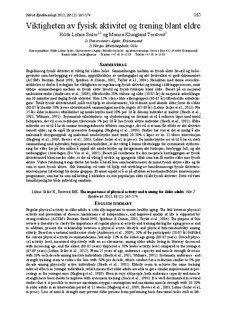| dc.description.abstract | Regular physical activity in older adults is critically important to ensure healthy aging. The link between physical activity and prevention of disease, maintenance of independence, and improved quality of life is supported by strong evidence (ACSM's Position Stand 1998; Spirduso & Cronin, 2001; Taylor et al., 2004). The purpose of this review is therefore to clarify the importance of regular physical activity and training during the aging process and in addition, present the relationship between a physical active lifestyle and physical function/mobility among elderly. Based on a national multicenter study (Anderssen et al., 2009), 20% of the participants (20-85 år) fulfilled the current physical activity recommendations, but only 12% in the oldest age group (80-85 years). Overall physical activity level, measured objectively with an accelerometer, among older adults living in Norway decreased with increasing age, and the oldest (80-85 years) displayed a 50% lower activity level compared to the youngest (65-69 years) (Lohne-Seiler et al., 2012). From 25 years of age, endurance capacity and muscle strength decrease with 10% each decade among inactive individuals (Heath et al., 1981; Wilmore, 1991). Systematic endurance- and strength training seem to reduce the loss with 50% per decade, which conduct for a reduction similar to 5% per decade among physically active individuals (Heath et al., 1981). Elderly seem to achieve the same training induced effects as younger individuals, which means that older adults are able to get a similar improvement in percentage as the younger ones (Hagberg et al., 1989). Even in very old people, both endurance capacity and muscle strength have been shown to improve with systematic training (Seals et al., 1984). It is well documented in several studies that it is possible to increase maximum oxygen consumption and maximum muscle strength with 10-20% in older adults in an intervention period of 12 weeks (Hagberg et al., 1989; Reeves et al., 2003; Lohne-Seiler et al, in press). Loss of muscle strength may prevent older persons from performing basic functional tasks such as lifting and moving objects, rising from a chair, and walking. Muscle strength seems therefore to be of greater importance in the ability to perform activities of daily living, compared to endurance capacity (Fiatarone et al., 1990). Increase in muscle strength may lead to improvements in functional capacity and prevent falls, dependency, and disability in later life (de Vos et al., 2005). The focus has to be targeted towards both endurance training in older adults, but not least towards systematic strength training. This way the elderly will achieve a much stronger body, and therefore will be better prepared to manage the activities of daily living and become more independent. Based on the results from the national screening of physical activity level among Norwegian elderly, it is now important to develop and initiate interventions with the goal to increase the physical activity level among the older adults living in Norway. Further research is therefore needed to better understand what characterize the least physical active elderly and the ones who are most physical active. In addition, another aspect is to measure the effect of low cost intervention studies where the goal is to recruit a high number of the elderly population. This would help guide the development of needed physical activity interventions targeted at older adults. | no_NO |
